Loading AI tools
Species in mammal family Cervidae From Wikipedia, the free encyclopedia
Cervidae is a family of hoofed ruminant mammals in the order Artiodactyla. A member of this family is called a deer or a cervid. They are widespread throughout North and South America, Europe, and Asia, and are found in a wide variety of biomes. Cervids range in size from the 60 cm (24 in) long and 32 cm (13 in) tall pudú to the 3.4 m (11.2 ft) long and 3.4 m (11.2 ft) tall moose. Most species do not have population estimates, though the roe deer has a population size of approximately 15 million, while several are considered endangered or critically endangered with populations as low as 200. One species, Père David's deer, is extinct in the wild, and one, Schomburgk's deer, went extinct in 1938.
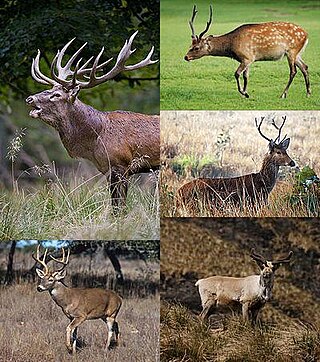
The fifty-five species of Cervidae are split into nineteen genera within two subfamilies: Capreolinae (New World deer) and Cervinae (Old World deer). Extinct species have also been placed into Capreolinae and Cervinae. More than one hundred extinct Cervidae species have been discovered, though due to ongoing research and discoveries the exact number and categorization is not fixed.[1]
| Conservation status | |
|---|---|
| EX | Extinct (1 species) |
| EW | Extinct in the wild (1 species) |
| CR | Critically Endangered (2 species) |
| EN | Endangered (6 species) |
| VU | Vulnerable (16 species) |
| NT | Near threatened (4 species) |
| LC | Least concern (16 species) |
| Other categories | |
| DD | Data deficient (9 species) |
| NE | Not evaluated (0 species) |
Conservation status codes listed follow the International Union for Conservation of Nature (IUCN) Red List of Threatened Species. Range maps are provided wherever possible; if a range map is not available, a description of the cervid's range is provided. Ranges are based on the IUCN Red List for that species unless otherwise noted. All extinct species or subspecies listed alongside extant species went extinct after 1500 CE, and are indicated by a dagger symbol "†".
The family Cervidae consists of 55 extant species belonging to 19 genera in 2 subfamilies and divided into dozens of extant subspecies. This does not include hybrid species or extinct prehistoric species. Additionally, one species, Schomburgk's deer, went extinct in 1938.[2] The classification is based on the molecular phylogeny.[3][4][5]
The following classification is based on the taxonomy described by Mammal Species of the World (2005), with augmentation by generally accepted proposals made since using molecular phylogenetic analysis.[3][4][5] This includes merging the two moose species of Alces into one, splitting out the monotypic Panolia genus from Rucervus, combining the monotypic subfamily Hydropotinae with Capreolinae. There are several additional proposals which are disputed, such as addition of the fair brocket to the Mazama genus, which are not included here.[6][7]
| Common name | Scientific name and subspecies | Range | Size and ecology | IUCN status and estimated population |
|---|---|---|---|---|
| Moose | A. alces (Linnaeus, 1758) Nine subspecies
|
North America, Europe, and Asia |
Size: 230–340 cm (91–134 in) long, plus 8–12 cm (3–5 in) tail; up to 230 cm (91 in) tall at shoulder[8] Habitat: Forest and inland wetlands[9] Diet: Vegetative parts of trees, as well as shrubs, herbs, and aquatic plants[9] |
LC |
| Common name | Scientific name and subspecies | Range | Size and ecology | IUCN status and estimated population |
|---|---|---|---|---|
| Roe deer | C. capreolus (Linnaeus, 1758) Four subspecies
|
Europe |
Size: 104–124 cm (41–49 in) long, plus 2–3 cm (1–1 in) tail; 66–84 cm (26–33 in) tall at shoulder[11] Habitat: Forest, shrubland, grassland, and inland wetlands[12] Diet: Wide variety of plants[12][11] |
LC
|
| Siberian roe deer | C. pygargus (Pallas, 1771) Four subspecies
|
Central and northeastern Asia | Size: 95–140 cm (37–55 in) long, plus 20–40 cm (8–16 in) tail; 65–95 cm (26–37 in) tall at shoulder[13] Habitat: Forest, shrubland, grassland, and inland wetlands[14] Diet: Grasses[14] |
LC
|
| Common name | Scientific name and subspecies | Range | Size and ecology | IUCN status and estimated population |
|---|---|---|---|---|
| Water deer | H. inermis Swinhoe, 1870 Two subspecies
|
East China and Korean peninsula | Size: 89–103 cm (35–41 in) long, plus 6–7 cm (2–3 in) tail; 45–57 cm (18–22 in) tall at shoulder[15] Habitat: Forest, shrubland, grassland, inland wetlands, and intertidal marine[16] Diet: Reeds, coarse grasses, vegetables, and beets[16][17] |
VU
|
| Common name | Scientific name and subspecies | Range | Size and ecology | IUCN status and estimated population |
|---|---|---|---|---|
| Marsh deer | B. dichotomus (Illiger, 1815) |
Scattered parts of central South America (former range in red) |
Size: 153–191 cm (60–75 in) long, plus 12–16 cm (5–6 in) tail; 110–127 cm (43–50 in) tall at shoulder[18] Habitat: Savanna, shrubland, and inland wetlands[19] Diet: Grasses, reeds and aquatic plants, as well as shrubs and vines[19] |
VU
|
| Common name | Scientific name and subspecies | Range | Size and ecology | IUCN status and estimated population |
|---|---|---|---|---|
| South Andean deer | H. bisulcus (Molina, 1782) |
Southern Andes mountains |
Size: 144–156 cm (57–61 in) long, plus 12–13 cm (5–5 in) tail; 80–90 cm (31–35 in) tall at shoulder[20] Habitat: Forest, shrubland, grassland, inland wetlands, rocky areas, and desert[21] Diet: Varied range of grasses and other plants[21] |
EN
|
| Taruca | H. antisensis (d'Orbigny, 1834) |
Andes mountains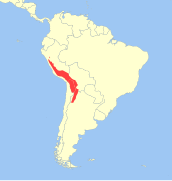 |
Size: 69–77 cm (27–30 in) tall at shoulder[22] Habitat: Shrubland, grassland, rocky areas, and other[23] Diet: Sedges and grasses[22][23] |
VU
|
| Common name | Scientific name and subspecies | Range | Size and ecology | IUCN status and estimated population |
|---|---|---|---|---|
| Amazonian brown brocket | M. nemorivaga (F. Cuvier, 1817) |
Northern and central South America |
Size: 75–100 cm (30–39 in) long, plus 6–11 cm (2–4 in) tail; 50 cm (20 in) tall at shoulder[24] Habitat: Forest and shrubland[25] Diet: Fruit, as well as leaves and shoots[24] |
LC
|
| Central American red brocket | M. temama (Kerr, 1792) Three subspecies
|
Central America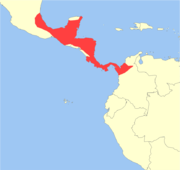 |
Size: 80–110 cm (31–43 in) long, plus 10–14 cm (4–6 in) tail; 60–70 cm (24–28 in) tall at shoulder[24] Habitat: Forest, shrubland, grassland, and inland wetlands[26] Diet: Fruit, as well as seeds, grass, shoots, vines, and sometimes crops such as beans[24] |
DD
|
| Dwarf brocket
|
M. chunyi Hershkovitz, 1959 |
Central Andes mountains |
Size: About 70 cm (28 in) long; about 38 cm (15 in) tall at shoulder[27] Habitat: Forest, shrubland, and grassland[28] Diet: Fruit and shrubs[28] |
VU
|
| Gray brocket | M. gouazoubira (Fischer von Waldheim, 1814) Eleven subspecies
|
Eastern South America |
Size: 85–105 cm (33–41 in) long[24] Habitat: Forest, savanna, shrubland, and inland wetlands[29] Diet: Wide variety of plants as well as fruit[29] |
LC
|
| Little red brocket | M. rufina (Bourcier, Pucheran, 1852) |
Northern Andes mountains |
Size: About 78 cm (31 in) long, plus 8 cm (3 in) tail; about 45 cm (18 in) tall at shoulder[30] Habitat: Forest, shrubland, and grassland[31] Diet: Herbs as well as other plants[31] |
VU
|
| Mérida brocket
|
M. bricenii Thomas, 1908 |
Northern Andes mountains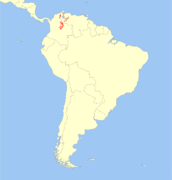 |
Size: 80–95 cm (31–37 in) long, plus 8–9 cm (3–4 in) tail; 45–50 cm (18–20 in) tall at shoulder[24] Habitat: Forest, shrubland, grassland, and rocky areas[32] Diet: Fruit and shrubs[32] |
VU
|
| Pygmy brocket | M. nana (Hensel, 1872) |
Southeastern South America (possible range in yellow) |
Size: About 78 cm (31 in) long, plus 8 cm (3 in) tail; less than 50 cm (20 in) tall at shoulder[30] Habitat: Forest[33] Diet: Unknown[24][33] |
VU
|
| Red brocket | M. americana (Erxleben, 1777) Twelve subspecies
|
Northern and central South America |
Size: 103–146 cm (41–57 in) long, plus 8–15 cm (3–6 in) tail; 65–80 cm (26–31 in) tall at shoulder[34] Habitat: Forest[35] Diet: Fruit and shrubs[35] |
DD
|
| Small red brocket | M. bororo Duarte, 1996 |
Atlantic Forest in southeastern Brazil (possible range in yellow) |
Size: 85 cm (33 in) long, plus 11–14 cm (4–6 in) tail; 50–60 cm (20–24 in) tall at shoulder[24] Habitat: Forest[36] Diet: Fruit, leaves, and sprouts[24] |
VU
|
| Common name | Scientific name and subspecies | Range | Size and ecology | IUCN status and estimated population |
|---|---|---|---|---|
| Mule deer | O. hemionus (Rafinesque, 1817) Ten subspecies
|
Western North America |
Size: 152–203 cm (60–80 in) long; 80–106 cm (31–42 in) tall at shoulder[37] Habitat: Forest, savanna, shrubland, grassland, inland wetlands, desert, and intertidal marine[38] Diet: Leaves, twigs, acorns, legume seeds, and fleshy fruits[37][38] |
LC
|
| Yucatan brown brocket | O. pandora (Merriam, 1901) |
Yucatán Peninsula |
Size: About 105 cm (41 in) long, plus 8 cm (3 in) tail[39] Habitat: Forest, shrubland, and grassland[40] Diet: Fruit, as well as other plants[24] |
VU
|
| White-tailed deer | O. virginianus (Rafinesque, 1832) 38 subspecies
|
North America and northern South America |
Size: 150–200 cm (59–79 in) long, plus 10–28 cm (4–11 in) tail[41] Habitat: Forest, savanna, shrubland, grassland, inland wetlands, desert, neritic marine, intertidal marine, and coastal marine[42] Diet: Wide variety of vegetation and grasses[42] |
LC
|
| Common name | Scientific name and subspecies | Range | Size and ecology | IUCN status and estimated population |
|---|---|---|---|---|
| Pampas deer | O. bezoarticus (Linnaeus, 1758) Five subspecies
|
Scattered central South America |
Size: 110–140 cm (43–55 in) long; 70–75 cm (28–30 in) tall at shoulder[43] Habitat: Savanna, grassland, and inland wetlands[44] Diet: Grasses and shrubs[43][44] |
NT
|
| Common name | Scientific name and subspecies | Range | Size and ecology | IUCN status and estimated population |
|---|---|---|---|---|
| Northern pudú
|
P. mephistophiles (Winton, 1896) |
Northern Andes mountains |
Size: 60–85 cm (24–33 in) long plus 3–5 cm (1–2 in) tail; 32–35 cm (13–14 in) tall at shoulder[45][46] Habitat: Forest, shrubland, and grassland[47] Diet: Leaves of ferns, trees, vines, herbs and shrubs[47][48] |
DD
|
| Southern pudú | P. puda (Molina, 1782) |
Southern Andes mountains |
Size: 60–85 cm (24–33 in) long plus 3–5 cm (1–2 in) tail; 35–45 cm (14–18 in) tall at shoulder[45][46] Habitat: Forest and shrubland[49] Diet: Leaves of ferns, trees, vines, herbs and shrubs[48][49] |
NT
|
| Common name | Scientific name and subspecies | Range | Size and ecology | IUCN status and estimated population |
|---|---|---|---|---|
| Reindeer | R. tarandus (Linnaeus, 1758) Fourteen subspecies
|
Arctic North America, Europe, and Asia |
Size: 150–230 cm (59–91 in) long; up to 120 cm (47 in) tall at shoulder[50] Habitat: Forest and grassland[51] Diet: Lichen, forbs, sedges, grasses, and shrubs[51] |
VU
|
| Common name | Scientific name and subspecies | Range | Size and ecology | IUCN status and estimated population |
|---|---|---|---|---|
| Tufted deer | E. cephalophus H. Milne-Edwards, 1872 Four subspecies
|
Central China and northeastern Myanmar | Size: 110–160 cm (43–63 in) long, plus 7–16 cm (3–6 in) tail; 50–70 cm (20–28 in) tall at shoulder[52] Habitat: Forest and shrubland[53] Diet: Grass, as well as shrubs, fruits, bamboo, and herbs[53] |
NT
|
| Common name | Scientific name and subspecies | Range | Size and ecology | IUCN status and estimated population |
|---|---|---|---|---|
| Bornean yellow muntjac
|
M. atherodes Groves, Grubb, 1982 |
Borneo | Size: 90–100 cm (35–39 in) long, plus 14–20 cm (6–8 in) tail; 65 cm (26 in) tall at shoulder[54][55] Habitat: Forest[56] Diet: Herbs, seeds, grass, buds, leaves, and fruit[54] |
NT
|
| Fea's muntjac | M. feae (Thomas, Doria, 1889) |
Southern Myanmar and Thailand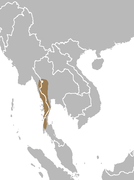 |
Size: 90–100 cm (35–39 in) long, plus 10–17 cm (4–7 in) tail; 50–60 cm (20–24 in) tall at shoulder[54] Habitat: Forest[57] Diet: Fruit and leaves, as well as grass and shoots[54] |
DD
|
| Giant muntjac
|
M. vuquangensis (Tuoc, Dung, Dawson, Arctander, & Mackinnon, 1994) |
Northern Vietnam and Laos |
Size: 110–115 cm (43–45 in) long, plus 17 cm (7 in) tail; 65–70 cm (26–28 in) tall at shoulder[54] Habitat: Forest[58] Diet: Fruit and leaves[54] |
CR
|
| Gongshan muntjac
|
M. gongshanensis Ma, 1990 |
South-central China |
Size: 95–105 cm (37–41 in) long, plus 9–16 cm (4–6 in) tail; 55–57 cm (22–22 in) tall at shoulder[59] Habitat: Forest[60] Diet: Unknown[54][60] |
DD
|
| Hairy-fronted muntjac | M. crinifrons (P. L. Sclater, 1885) |
Southeastern China | Size: 98–113 cm (39–44 in) long, plus 21 cm (8 in) tail[61] Habitat: Forest and shrubland[62] Diet: Wide variety of tree leaves and twigs, forbs, grass, and fruit[62] |
VU
|
| Leaf muntjac
|
M. putaoensis Amato, Egan & Rabinowitz, 1999 |
Myanmar | Size: 77–83 cm (30–33 in) long, plus 8–12 cm (3–5 in) tail; 50 cm (20 in) tall at shoulder[63] Habitat: Forest[64] Diet: Fruit and a range of plant materials[64] |
DD
|
| Northern red muntjac | M. vaginalis (Boddaert, 1785) |
Southern and Southeast Asia | Size: 89–135 cm (35–53 in) long, plus 13–23 cm (5–9 in) tail; 40–65 cm (16–26 in) tall at shoulder[65] Habitat: Forest[66] Diet: Fruit, buds, tender leaves, flowers, herbs, and young grass[66] |
LC
|
| Pu Hoat muntjac
|
M. puhoatensis Trai, 1997 |
Vietnam | Size: Small and similar to the Truong Son muntjac, but specific measurements not available[54] Habitat: Forest[67] Diet: Unknown[54][67] |
DD
|
| Reeves's muntjac | M. reevesi (Ogilby, 1839) Three subspecies
|
Eastern China; introduced to Britain and Japan | Size: 70–113 cm (28–44 in) long, plus 10 cm (4 in) tail; 43–45 cm (17–18 in) tall at shoulder[68] Habitat: Forest, shrubland, and grassland[69] Diet: Bamboo, seeds, bark, fruit and foliage, as well as eggs, carrion, small mammals, and ground-nesting birds[68][69] |
LC
|
| Roosevelt's muntjac
|
M. rooseveltorum Osgood, 1932 |
 |
Size: Small with shoulder height estimated at about 40 cm (16 in), but specific measurements not available[54] Habitat: Forest[70] Diet: Leaves and fruit[54] |
DD
|
| Southern red muntjac | M. muntjak (Zimmermann, 1780) |
Southeast Asia | Size: 89–135 cm (35–53 in) long, plus 13–23 cm (5–9 in) tail; 40–65 cm (16–26 in) tall at shoulder[65] Habitat: Forest[71] Diet: Fruit, buds, tender leaves, flowers, herbs, and young grass[71] |
LC
|
| Truong Son muntjac
|
M. truongsonensis (Giao, Tuoc, Dung, Wikramanayake, Amato, Arctander, & Mackinnon, 1997) |
Southern Vietnam | Size: Small with shoulder height estimated at about 40 cm (16 in), but specific measurements not available[54] Habitat: Forest[72] Diet: Leaves and fruit[54] |
DD
|
| Common name | Scientific name and subspecies | Range | Size and ecology | IUCN status and estimated population |
|---|---|---|---|---|
| Chital | A. axis (Erxleben, 1777) |
Indian subcontinent |
Size: 70 cm (28 in) long plus 20 cm (8 in) tail; 35–38 cm (14–15 in) tall at shoulder[73][74] Habitat: Forest, savanna, and grassland[75] Diet: Wide variety of grasses as well as fallen leaves, flowers, and fruit[75] |
LC
|
| Calamian deer | A. calamianensis (Heude, 1888) |
Calamian Islands of the Philippines | Size: 100–175 cm (39–69 in) long, plus 12–38 cm (5–15 in) tail; 60–100 cm (24–39 in) tall at shoulder[76] Habitat: Forest, savanna, and grassland[77] Diet: Leaves[77] |
EN
|
| Bawean deer | A. kuhlii (Temminck, 1836) |
Bawean island of Indonesia |
Size: 100–175 cm (39–69 in) long[78] Habitat: Forest and grassland[79] Diet: Herbs and grasses, as well as young leaves and twigs[79] |
CR
|
| Indian hog deer | A. porcinus (Zimmermann, 1780) |
Southern and southeast Asia |
Size: 105–115 cm (41–45 in) long, plus 20 cm (8 in) tail; 60–72 cm (24–28 in) tall at shoulder[80] Habitat: Savanna, shrubland, grassland, and inland wetlands[81] Diet: Young grasses, as well as herbs, flowers, fruit, and shrubs[81] |
EN
|
| Common name | Scientific name and subspecies | Range | Size and ecology | IUCN status and estimated population |
|---|---|---|---|---|
| Thorold's deer | C. albirostris Przhevalsky, 1883 |
Central China | Size: 155–210 cm (61–83 in) long, plus 10–13 cm (4–5 in) tail; 115–140 cm (45–55 in) tall at shoulder[82] Habitat: Forest, shrubland, and grassland[83] Diet: Grass, herbs, lichens, leaves, and bark of trees and bushes[83] |
VU
|
| Elk | C. canadensis Erxleben, 1777 Thirteen subspecies
|
North America and Asia (former range in light green) |
Size: 210–280 cm (83–110 in) long plus 10–22 cm (4–9 in) tail; 120–175 cm (47–69 in) tall at shoulder[84][85] Habitat: Forest, shrubland, and grassland[86] Diet: Shrub and tree shoots, as well as grasses, sedges, and shrubs[86] |
LC
|
| Red deer | C. elaphus Linnaeus, 1758 Nine subspecies
|
Europe and western Asia (former range in light green) |
Size: 160–270 cm (63–106 in) long; 75–150 cm (30–59 in) tall at shoulder[87] Habitat: Forest, shrubland, grassland, and rocky areas[88] Diet: Shrub and tree shoots, as well as grasses, sedges, shrubs, fruit, and seeds[88] |
LC
|
| Central Asian red deer | C. hanglu Wagner, 1844 Three subspecies
|
Central Asia | Size: Habitat: Forest, shrubland, grassland, and inland wetlands[89] Diet: Branches of young deciduous trees[89] |
LC
|
| Sika deer | C. nippon Temminck, 1838 Sixteen subspecies
|
East Asia | Size: 95–180 cm (37–71 in) long plus 7–13 cm (3–5 in) tail; 64–109 cm (25–43 in) tall at shoulder[90] Habitat: Forest, shrubland, and grassland[91] Diet: Grass, as well as shrubs and fruit[91] |
LC
|
| Common name | Scientific name and subspecies | Range | Size and ecology | IUCN status and estimated population |
|---|---|---|---|---|
| European fallow deer | D. dama (Linnaeus, 1758) |
Europe and west Asia; introduced scattered areas worldwide (in teal) |
Size: 130–175 cm (51–69 in) long, plus 15–23 cm (6–9 in) tail; 90–100 cm (35–39 in) tall at shoulder[92] Habitat: Forest, shrubland, and grassland[93] Diet: Grasses, mast, and shrubs, as well as leaves, buds, shoots, and bark[92][93] |
LC
|
| Persian fallow deer | D. mesopotamica (Brooke, 1875) |
Iran and Israel | Size: 130–175 cm (51–69 in) long, plus 15–23 cm (6–9 in) tail; 90–100 cm (35–39 in) tall at shoulder[92] Habitat: Forest, savanna, and shrubland[94] Diet: Grasses, mast, and shrubs, as well as leaves, buds, shoots, and bark[94] |
EN
|
| Common name | Scientific name and subspecies | Range | Size and ecology | IUCN status and estimated population |
|---|---|---|---|---|
| Père David's deer | E. davidianus Milne-Edwards, 1866 |
China | Size: 183–216 cm (72–85 in) long, plus 22–36 cm (9–14 in) tail[95] Habitat: Grassland, inland wetlands, and intertidal marine[96] Diet: Grass, reeds, and bush leaves[96] |
EW
|
| Common name | Scientific name and subspecies | Range | Size and ecology | IUCN status and estimated population |
|---|---|---|---|---|
| Eld's deer | P. eldii (McClelland, 1842) Three subspecies
|
Scattered parts of southeast Asia | Size: 140–170 cm (55–67 in) long, plus 22–25 cm (9–10 in) tail; 90–130 cm (35–51 in) tall at shoulder[97] Habitat: Forest, savanna, shrubland, grassland, and inland wetlands[98] Diet: A variety of grasses, fruit, and herbaceous and wetland plants[99][98] |
EN
|
| Common name | Scientific name and subspecies | Range | Size and ecology | IUCN status and estimated population |
|---|---|---|---|---|
| Barasingha | R. duvaucelii (Cuvier, 1823) Three subspecies
|
Scattered parts of south Asia (historical range in yellow)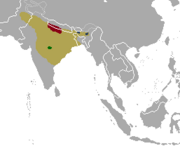 |
Size: About 180 cm (71 in) long; 119–124 cm (47–49 in) tall at shoulder[100] Habitat: Forest, savanna, grassland, and inland wetlands[101] Diet: Grass and aquatic plants[101] |
VU
|
| Schomburgk's deer† | R. schomburgki Blyth, 1863 |
Central Thailand | Size: Unknown Habitat: Grassland and inland wetlands[102] Diet: Unknown[102] |
EX
|
| Common name | Scientific name and subspecies | Range | Size and ecology | IUCN status and estimated population |
|---|---|---|---|---|
| Visayan spotted deer | R. alfredi (P. L. Sclater, 1870) |
Philippines | Size: 120–130 cm (47–51 in) long, plus 8–13 cm (3–5 in) tail; 60–80 cm (24–31 in) tall at shoulder[103] Habitat: Forest, shrubland, and grassland[104] Diet: Cogon grass and young leaves and buds[104] |
EN
|
| Philippine deer | R. marianna (Desmarest, 1822) Four subspecies
|
Philippines | Size: 100–151 cm (39–59 in) long; 55–70 cm (22–28 in) tall at shoulder[105] Habitat: Forest and grassland[106] Diet: Grass[106] |
VU
|
| Javan rusa | R. timorensis (Blainville, 1822) Seven subspecies
|
Indonesia and East Timor |
Size: 142–185 cm (56–73 in) long, plus 10–30 cm (4–12 in) tail; 80–110 cm (31–43 in) tall at shoulder[107] Habitat: Forest, savanna, and grassland[108] Diet: Grass, herbs, the leaves and bark of shrubs, and seaweed[108] |
VU
|
| Sambar deer | R. unicolor (Kerr, 1792) Seven subspecies
|
South and Southeast Asia including Southern China |
Size: 160–270 cm (63–106 in) long, plus 25–30 cm (10–12 in) tail; 102–160 cm (40–63 in) tall at shoulder[109] Habitat: Forest, savanna, shrubland, grassland, and inland wetlands[110] Diet: Wide variety of plants[110] |
VU
|
Seamless Wikipedia browsing. On steroids.
Every time you click a link to Wikipedia, Wiktionary or Wikiquote in your browser's search results, it will show the modern Wikiwand interface.
Wikiwand extension is a five stars, simple, with minimum permission required to keep your browsing private, safe and transparent.